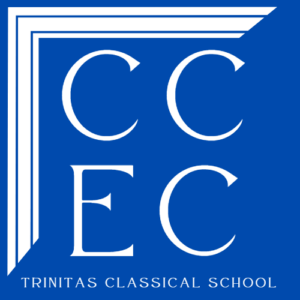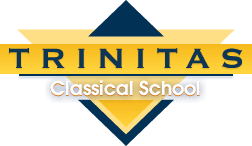 We continue our series on the three “R’s” of education with a post on ‘Riting (a.k.a. “Writing”) at Trinitas in grades 5-8. In previous posts, we’ve been exploring Francis Bacon’s idea that writing makes “an exact man.” Of course, not all writing makes persons more exact (think of most social media posts), but good writing, the kind of writing we strive to teach at Trinitas, does help students learn not merely to “express themselves,” but to conform their thoughts and words more and more to the realities, the possibilities, and the promise of God’s world and the Word. What does this look like in our upper grades?
We continue our series on the three “R’s” of education with a post on ‘Riting (a.k.a. “Writing”) at Trinitas in grades 5-8. In previous posts, we’ve been exploring Francis Bacon’s idea that writing makes “an exact man.” Of course, not all writing makes persons more exact (think of most social media posts), but good writing, the kind of writing we strive to teach at Trinitas, does help students learn not merely to “express themselves,” but to conform their thoughts and words more and more to the realities, the possibilities, and the promise of God’s world and the Word. What does this look like in our upper grades?
Writing in grades 5-8 builds on the strong foundation of observation, imitation, drill, and practice built in grades K-4. Writing instruction continues to be tied to literature instruction because we believe that students learn how to write well by learning how to read well. Both of these skills require learning how to listen well. Because of this, teacher and students read large portions of many of the texts, especially the difficult ones, aloud in class. And together they make observations, from the smallest details and literary devices to the largest ultimate questions about Man, his relationship to God and to Nature, and the meaning of life.
The details and devices that Trinitas students learn to identify and use in their own writing include, but are not limited to, the following (Warning–this list may include terms with which you are unfamiliar): diction, transitions, parallelism, antithesis, anastrophe, parenthesis, asyndeton, polysyndeton, alliteration, anaphora, epistrophe, epanalepsis, anadiplosis, climax, antimetabole, polyptoton, chiasmus, metaphor, simile, personification, irony, onomatopoeia, allegory, synecdoche, metonymy, hyperbole, periphrasis, pun, antanaclasis, oxymoron, interragatio, and dubitatio. By the time a Trinitas student graduates, he or she will have gained some facility with all of these, and some of them will have become second nature. Most schools do not teach these tools until senior year of high school, if then.
Someone might ask why we teach all of these tools so early. Someone might even ask why anyone teaches them ever. We teach them early because students are capable of learning them. We teach them because study in any field—academics or sports or music or….—involves increasing depth of understanding and skill which can be used for some external purpose or simply enjoyed for their own sake. Take the literary device of anaphora, for example—the repetition of a word or phrase at the beginning of sentences—the repetition emphasizes ideas and adds rhythm and can be used to stir up an audience in order to inspire, convince, or challenge. It can also be memorable and a pleasure to read. Recall Winston Churchill’s 1940 speech in the House of Commons: “We shall fight in France, we shall fight on the seas and the oceans…we shall fight on the beaches, we shall fight on the landing grounds…” Or, Martin Luther King Jr.’s 1963 speech in Washington D.C.: “I have a dream that one day this nation will rise up and live out the true meaning of its creed: ‘We hold these truths to be self-evident: that all men are created equal.’ I have a dream that one day on the red hills of Georgia the sons of former slaves and the sons of former slave owners will be able to sit down together at the table of brotherhood….I have a dream that my four little children will one day live in a nation where they will not be judged by the color of their skin but by the content of their character….” Students may also find the tool useful in their own lives, for example, “We should get a dog because…We should get a dog because….We should get a dog because….” (We recently got a dog.)
Guided by the teacher, Trintias students move back and forth between observations of literary details and discussions about ultimate questions. They begin these broader conversations from the standpoint of St. Augustine, who said, “Oh Lord, You have created us for yourself, and our heart is restless until it rests in you.” They learn to read with compassion and have “conversations” with both authors who have found rest and those who are restless. At the start of the school year, our literature and composition teacher facilitates a “discussion” between Christian allegorist John Bunyan (Pilgrim’s Progress) and dark romantic author Nathaniel Hawthorne (“The Celestial Railroad”). Later in the year, students “observe” a meeting between Abraham Lincoln and Harriet Beecher Stowe (Uncle Tom’s Cabin) and come to understand why he commented that she was “the little woman who wrote the book that started this great war.” They appreciate the power of writing to de-humanize or to humanize others. In “conversation” with George Orwell (Animal Farm), they can see that good intentions within a man-centered, Godless worldview lead not to individual freedom, but to dictatorship and tyranny. Hellen Keller (The Story of My Life) and Chaim Potok (The Chosen) have much to teach them about character growth in the face of trials. Shakespeare speaks to them about life as tragedy (Macbeth) and as comedy (The Tempest). Jane Austen (Sense and Sensibility) asks them to consider whether it is better to live life by passionate emotion or constrained reason.
Trinitas students take these literary observations and discussions, and they write. And re-write. And re-write. They learn early on that critique and revision are essential parts of writing and that larger projects are built from well-outlined or well-mapped smaller ones. They alternate between analytical (expository or persuasive) and creative writing. They write single paragraphs, five-paragraph essays, research papers—all with a goal of creating well-crafted arguments supported with clear claims, evidence, and explanations. They write their own narrative stories illustrating facility with plot, setting, and character. In all of this writing, the literature they are reading provides material for thought and practice, “grist for the mill,” as Dorothy Sayers refers to it.
Poetry is another important component of the curriculum. Trinitas students learn how to read poetry. They read it aloud. They memorize and recite it. They learn about different types of poetry. They study the elements of poetry that, like the literary elements listed above, are not likely to be taught again until an advanced placement class late in high school. They write their own poetry with rhyme and meter. They study the changing worldviews exhibited in various periods of American poetry, a unit that culminates in students composing their own poems in the style and worldview of various literary periods.
Throughout all this, the upper grade students continue their study of English (and Latin and Greek) grammar, analyzing and diagraming increasingly complex sentence structures. They study these in part to reinforce a comprehension of the logic of word order, to develop critical thinking skills by diligently seeking to ask the right questions, and simply to delight in language.
When we talk with families who are considering Trinitas, we often ask them to look at the writing of our students, not just the “best” writers in the school, all of the students. Trinitas teaches all students to write. Some by inclination and talent will be better initially. Some by hard work and determination will excel. All will learn to write because they are all being taught how to write. Simply put, our goal is to develop competent writers who are not afraid of a blank sheet of paper and are able to craft a thoughtful essay. One test of this is the timed writing prompt essay. We are continually impressed with what the students are able to compose in a very short period of time. In a way, they have become like athletes who, when a ball is thrown, do not flinch, but rather confidently respond to catch it. The training method is no secret, it can be seen in Francis Bacon’s quotation: “Reading maketh a full man; conference a ready man; and writing an exact man.” At Trinitas, we teach exact-man-making writing.
© ALP
